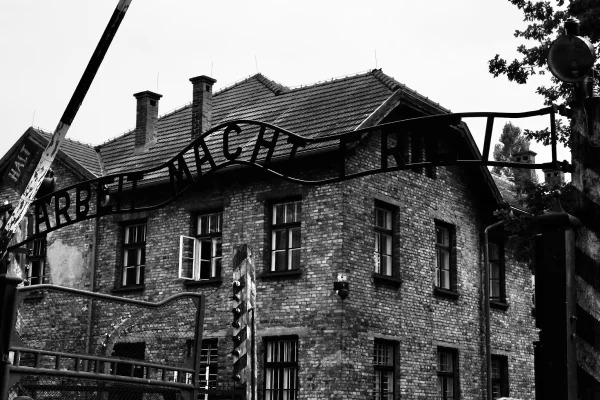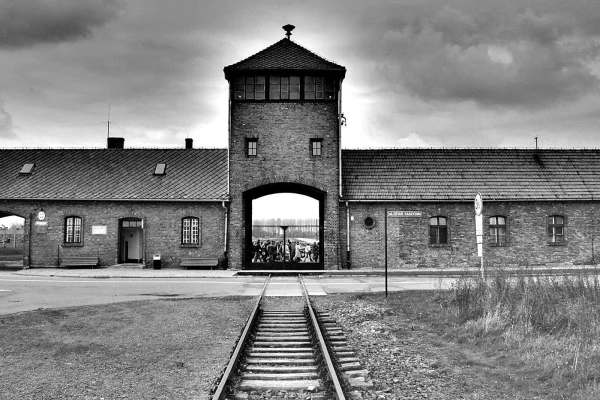The history of Auschwitz is a haunting tale of human cruelty and resilience. Auschwitz, located in German-occupied Poland, was the largest of the Nazi concentration and extermination camps. Established in 1940, it quickly became a symbol of the Holocaust, where over 1.1 million people, mostly Jews, were murdered. The camp’s history spans its construction, operation, and eventual liberation, leaving behind a legacy that the world must never forget.

The construction of Auschwitz began in April 1940 under the direction of SS officer Rudolf Höss. The site, located in Oświęcim, Poland, was chosen for its strategic location near major railway lines, which facilitated the transport of prisoners from across Nazi-occupied Europe. Initially, the camp was intended to house Polish political prisoners, but it quickly expanded to become the largest and most notorious of the Nazi concentration and extermination camps.
Auschwitz I, the original camp, was established in a former Polish army barracks. The Nazis repurposed the existing structures, adding barbed wire fences, watchtowers, and other security measures. The first prisoners were Polish political detainees who were forced to expand the camp and construct new buildings. Over time, Auschwitz I included barracks, administrative offices, various blocks, and the infamous Block 11, where prisoners were held and forced into labor.
In October 1941, construction began on Auschwitz II-Birkenau, located about 3 kilometers from the main camp. Birkenau was designed to accommodate the large-scale extermination of Jews as part of the Final Solution. The camp included vast barracks, four large gas chambers, and crematoria, where thousands of victims were murdered daily. The gas chambers at Birkenau were equipped with underground undressing rooms and large gas chambers disguised as showers, enhancing the efficiency of the extermination process. The expansion of Auschwitz II-Birkenau marked a significant shift in the camp’s function, transforming it into a center of industrialized genocide.



Life in Auschwitz was characterized by unimaginable suffering and brutality. Prisoners faced overcrowded barracks, insufficient food, and rampant disease. They were subjected to grueling labor, medical experiments, and constant fear of execution. Despite these horrors, there were instances of resilience and solidarity among prisoners. The daily struggle for survival defined the existence of those imprisoned in Auschwitz.
The so-called “Auschwitz House” refers to the barracks where prisoners were housed. These buildings were originally designed for military purposes but were repurposed by the Nazis to hold hundreds of prisoners in each block. The conditions inside were deplorable, with prisoners crammed into tight spaces on wooden bunks, often infested with lice and rats. There was little to no heating during the harsh winters and sanitation facilities were grossly inadequate, contributing to the spread of diseases.
The prisoners in Auschwitz came from various backgrounds, including Jews, Poles, Roma, Soviet POWs, and political dissidents. Each group faced unique forms of persecution and brutality. Upon arrival, prisoners were stripped of their identities, given numbers in place of names, and forced into labor.
Auschwitz was liberated by the Soviet Red Army on January 27, 1945. As the Allies advanced, the Nazis attempted to cover up their crimes by dismantling gas chambers and crematoria. They also forced prisoners on death marches to other camps. When the Soviets arrived, they found about 7,000 surviving prisoners, many in dire condition. The liberation marked the end of Auschwitz’s operation but left a lasting scar on human history.
The history of Auschwitz is a stark reminder of the depths of human cruelty and the importance of remembering and learning from the past. Visiting Auschwitz today serves as a powerful educational experience, ensuring that the horrors of the Holocaust are never forgotten.

AUSCHWITZ TICKETS

AUSCHWITZ INFORMATION

TRAVELER INFORMATION
Auschwitz is open to visitors year-round except for January 1, December 25, and Easter Sunday. The visiting hours vary by season to… see more
